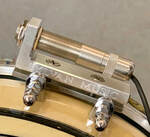|
We live in the golden age of guitar building. The available knowledge regarding guitar craftsmanship, the array of skilled manufacturers of all sorts and the world-wide demand for unique, personalized instruments is at an all time high. There's never been more variety in the market place when it comes to different options available to the consumer. From the thousands of different guitar pickups, tone woods, finish options, neck profile shapes, fret wire size to the various component values of guitar electronics... yikes! The options may seem overwhelming. When you're in the market for a guitar, it can be tough to distinguish how impactful any of these variables may be to you as the player. Let's break it down and take a look at three basic features to consider when evaluating a guitar: scale length, nut width and bridge spacing.
Scale length (or the measurement from the nut to the saddle) has a big impact on the feel, response and sound of the guitar. A shorter scale length like Gibson's 24.75" will have a looser feel, producing a warmer, more mellow tone whereas a longer scale length like Fender's 25.5" scale length has a tighter response with a brighter, snappier sound. Of course, a shorter scale length means the frets are closer together, which can make fretting chords more comfortable. The additional tension of a longer scale length can create louder projection, something to consider if you're looking for the next 'banjo killer' dreadnought. Nut width and bridge spacing really have to do with the physical comfort of the guitar more than impacting the sound of the instrument. As much as jumbo acoustics may feel cumbersome for smaller guitar players, you may consider a different nut width depending on the size of your hands. Players with large hands may prefer a wider nut width. A narrower a nut width means the strings are closer together, making intricate chord fingerings more challenging for larger hands but just right for players with smaller paws. Maybe you wrap your fretting hand thumb around the neck to fret the low E string, playing psychedelic RnB a la Jimi Hendrix or the thumbpicking style of Merle Travis? Both of these artists preferred a narrower nut width to facilitate their styles. Are you more of a fingerstyle player? You may find wider bridge spacing more comfortable for your picking hand. While these suggestions may serve as a general guide, these guitar measurements are really about your personal preference. Pick up your favorite guitar and consider its scale length, nut width and bridge spacing. What about that guitar really appeals to you? Is it comfortable? Maybe there's something about it that you wish were different. Go to your local guitar shop and play some instruments while keeping in mind these various options. If the exact combination of features isn't available on a guitar in your local shop, it's very possible one can be custom made to suit your preferences. Many boutique acoustic guitar makers such as Santa Cruz Guitar Co, Lowden and Goodall offer different scale lengths, nut widths and bridge spacings as custom options on their instruments. Good luck and happy strumming! - Gerard
12 Comments
8/3/2023 10:01:39 pm
The layout of this site is clean and uncluttered, making it easy to focus on the content. It's a pleasure to browse through the pages without any distractions.
Reply
2/22/2024 06:04:09 am
I'm glad you found the post interesting! If you have any questions about the topic or if there's anything else you'd like to know more about, feel free to ask. I'm here to help and share information with you!
Reply
2/26/2024 02:08:07 pm
Awesome! The additional tension of a longer scale length can create louder projection, something to consider if you're looking for the next 'banjo killer' dreadnought.
Reply
3/25/2024 06:01:19 am
Thanks for this nice effort which you put here in the shape of this post. I will must share this blog
Reply
6/17/2024 07:41:48 pm
Warm sunny morning, delicious noodles, great game Drift Boss and listening to warm music...great!
Reply
6/24/2024 10:53:26 am
Absolutely, Gerard! We indeed live in an exceptional era for guitar craftsmanship, with an unprecedented wealth of knowledge, skill, and variety at our disposal. The choices available to today's guitarists can indeed be daunting, but understanding some key aspects can significantly enhance the guitar shopping experience. Let’s delve a bit deeper into the three fundamental features you've highlighted: scale length, nut width, and bridge spacing.
Reply
Leave a Reply. |

 RSS Feed
RSS Feed



